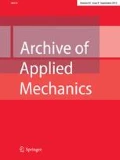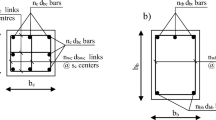Abstract
This paper describes a novel seismic optimal design method for the reinforced concrete frame. First, an optimal mathematical model with time-dependent constraints, i.e., inter-story drift constraints, is established for achieving minimum weight design. Second, the inequality constraint problem with time-dependent constraints is converted into a sequence of appropriately formed unconstrained problems using the integral interior point penalty function method. Third, an efficient algorithm of the first and second derivatives of the inter-story drift with respect to design variables is formulated based on Newmark-β method. Gradient and Hessian matrix of the integral interior penalty function are also computed. Fourth, Marquardt’s method is employed to solve a sequence of unconstrained problems. Finally, the minimum weight design of a three-story, two-bay planar frame is demonstrated using the new optimization method and the augmented Lagrange multiplier method. The comparative results show the seismic optimal design method presented in this paper is more efficient than the augmented Lagrange multiplier method in terms of computational time. The proposed new method is an effective and efficient approach for minimum weight design of the reinforced concrete frames subjected to earthquake excitation.
Similar content being viewed by others
References
Moehle, J.P., Mahin, S.A.: Observations on the behavior of reinforced concrete buildings during earthquakes. In: Ghosh, S.K. (ed.) Earthquake-Resistant Concrete Structures Inelastic Response and Design. American Concrete Institute SP-127 (1991)
International Conference of Building Officials. Uniform Building Code (UBC), vol. 2. Whittier, CA, USA (1997)
National Standard of the People’s Republic of China, Chinese Code for Seismic Design of Buildings (GB50011-2001). Beijing, China: Architecture and Building Press (2001)
Paulay T., Priestley M.J.N.: Seismic design of reinforced concrete and masonry buildings. Wiley, NY (1992)
Zarghamee M.S.: Optimum frequency of structures. AIAA J. 6(6), 749–750 (1968)
Lin Jiahao.: Optimum structure design with frequency forbidden domain constlaints. J. Dalian Ind. Inst. 20(1), 27–36 (1981) (in Chinese)
Wang Shenhang.: Structural optimization with frequency constraints. Acta Mech. Solida Sin. 2(2), 165–175 (1982)
Ramana G.: Structural optimization frequency constraints-a review. AIAA J. 31(12), 2296–2303 (1993)
Jaroslaw A.C., Stanislaw A.L.: Multimodal optimization of space frames for maximum frequency. Comput. Struct. 66(2–3), 187–199 (1998)
Fox R.L., Kapoor M.P.: Structural optimization in the dynamics regime—-a computational approach. AIAA J. 8(10), 1798–1804 (1970)
Feng T.T., Arora J.S., Haug E.J.: Optimal structural design under dynamic loads. Int. J. Numer. Methods Eng. 11, 39–52 (1977)
Cassis J.H., Schmit L.A.: Optimal structural designs with dynamic constraints. ASCE J. Struct. Div. 102, 2053–2071 (1976)
Kapoor, M.P., Kmarasamy, K.: Optimum configuration of transmission towers in dynamic response regime. In: Proceedings International Symposium on Optimum Structural Design, Tucson, Ariz, Oct 1981
Hsieh C.C., Arora J.S.: Design sensitivity analysis and optimization of dynamic response. Comput. Methods Appl. Mech. Eng. 43(2), 195–219 (1984)
Pantelides C.P., Tsan S.R.: Optimal design of dynamically constraints structures. Comput. Struct. 62(1), 141–150 (1997)
Arora J.S., Cardoso J.E.B.: A design sensitivity analysis principle and its implementation into ADINA. Comput. Struct. 32, 691–705 (1989)
Arora J.S., Chahande A.I., Paeng J.K.: Multiplier methods for engineering optimization. Int. J. Numer. Methods Eng. 32, 1485–1525 (1991)
Kocer F.Y., Arora J.S.: Optimal design of latticed towers subjected to earthquake loading. J. Struct. Eng. 128, 197–204 (2002)
Oral S., Ider S.K.: Optimum design of high-speed flexible robotic arms with dynamic behavior constraints. Comput. Struct. 65, 255–259 (1997)
Grandhi R.V., Haftka R.T., Watson L.T.: Design-oriented identification of critical times in transient response. AIAA J. 24, 649–656 (1986)
Hsieh C.C., Arora J.S.: A hybrid formulation for treatment of point-wise state variable constraints in dynamic response optimization. Comput. Methods Appl. Mech. Eng. 48(2), 171–189 (1985)
Hsieh C.C., Arora J.S.: An efficient method for dynamic response optimization. AIAA J. 23, 1484–1486 (1985)
Kang B.S., Choi W.S., Park G.J.: Structural optimization under equivalent static loads transformed from dynamic loads based on displacement. Comput. Struct. 79, 145–154 (2001)
Chahande A.I., Arora J.S.: Development of a multiplier method for dynamic response optimization problem. Struct. Optim. 6, 69–78 (1993)
Cassis J.H., Schmit L.A.: Optimum structural design with dynamic constraints. J. Struct. Eng. Proc. ASCE 102, 2053–2071 (1976)
Kang B.S., Park G.J., Arora J.S.: A review of optimization of structures subjected to transient loads. Struct. Multidisc Optim. 31, 81–95 (2006)
Kocer F.Y., Arora J.S.: Optimal design of h-frame transmission poles for earthquake loading. J. Struct. Eng. 125, 1299–1308 (1999)
van Keulen F., Haftka R.T., Kim N.H.: Review of options for structural design sensitivity analysis. Part 1: Linear systems. Comput. Methods Appl. Mech. Eng. 194, 3213–3243 (2005)
Bogomolni M., Kirsch U., Sheinman I.: Efficient design sensitivities of structures subjected to dynamic loading. Int. J. Solids Struct. 43, 5485–5500 (2006)
Kirsch U., Bogomolni M., van Keulen F.: Efficient finite-difference design-sensitivities. AIAA J. 43, 399–405 (2005)
Reklaitis G.V., Ravindran A., Ragsdell K.M.: Engineering Optimization Methods and Applications. Wiley, NY (1983)
Author information
Authors and Affiliations
Corresponding author
Rights and permissions
About this article
Cite this article
Liu, Q., Zhang, J. & Yan, L. An optimal method for seismic drift design of concrete buildings using gradient and Hessian matrix calculations. Arch Appl Mech 80, 1225–1242 (2010). https://doi.org/10.1007/s00419-009-0368-0
Received:
Accepted:
Published:
Issue Date:
DOI: https://doi.org/10.1007/s00419-009-0368-0




